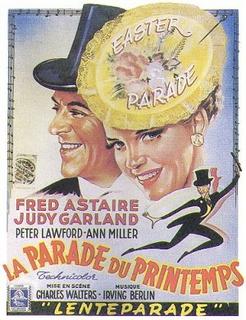Easter Parade

Before charming audiences and critics with "The Band Wagon", Fred Astaire stepped in at the last minute and saved another big budget MGM musical extravaganza. While he had appeared in several other smaller titles for the studio, this was his first of epic proportions. Initially to be directed by Vicente Minnelli, the film was instead entrusted to Charles Walters, a very young director who had already directed some profitable titles for the studio and was now reaping the rewards of his efforts by being given a critical and box office "sure thing". The reason Minnelli stepped aside was because of the film's leading lady, his wife, Judy Garland. The two had a tempestuous marriage to put it kindly, and it was advised that working together for twelve hours a day might not be the best thing for their sacred union. Joining Garland on the marquee was Gene Kelly, who was now a huge star for the studio after appearing in "Anchors Aweigh". The topper was the score, done by songwriting legend Irving Berlin, which automatically ensured the film more prestige and probably did not hurt the box office. The only problem: weeks before filming was to begin, Gene Kelly broke his ankle. In a magnanimous gesture rare for Hollywood where egos usually reign supreme, Kelly recommended Astaire for the role. In a twist of fate, this almost became the first pairing of Fred Astaire and Cyd Charisse, who would later star in "The Band Wagon" for MGM, but Charisse had to back out as well, when she became pregnant. Finally having their two leads and director, MGM began production on Irving Berlin's ode to Easter, "Easter Parade".
Much like "The Band Wagon", "Easter Parade" is made exponentially better by its sharp script, written by the MGM musical/comedy duo Albert Hackett and Frances Goodrich, and its star caliber supporting cast, in this case Peter Lawford and Ann Miller. The plot is typical musical fluff: Astaire and Miller are Don Hewes and Nadine Hale, a very popluar dancing team and couple. Nadine decides to break off (and break up) on her own, and in a vindictive gesture, Don boasts he can take the next person he sees and turn her into just as big a star as Nadine. That next person just happens to be Hannah Brown, a mild mannered chorus girl who is ultimately up to the task of being perfectionist Don's partner. While Nadine goes on to become a star in her own right, Don and Hannah have their growing pains, as Don is more concerned with topping Nadine and Hannah is so nervous working with such big star as Don Hewes. Once Don forgets his revenge scheme, he begins to realize that he is falling in love with the pretty but shy Hannah (who has been pursued by Don's playboy friend Johnathon, played in art-imitating-life fashion by Peter Lawford). The two do fall in love, and do become a big star duo on the vaudeville circuit (the film offers some spectacular numbers from their "act", "A Couple of Swells", "Steppin' Out With My Baby", and "When the Midnight Choo Choo Leaves for Alabam"). The film ends with the wonderful title tune, the MGM backlot Manhattan street brilliantly filled with light and color, and Don and Hannah happily arm and arm.
This film really should be recognized as the impetus to Fred Astaire's "second" career. After the resounding success he experienced with this, as well as his enjoyment working within the Freed Unit, Astaire worked as feverishly as ever. Over the next nine years he would make nine more musicals, and then had what you could call a "third" career, in which he played charming older men in supporting roles, all after he claimed he was "retired". The driving creative force behind many of the Astaire/MGM musicals was producer Arthur Freed. In the 1930's Freed was a renaissance man for the studio, doing some writing, producing, composing, and writing lyrics. By the 1940's he had become one of the studio's top producers and was quite prolific, as the "Freed Unit" as his stable of actors, writers, directors and songwriters came to be known, produced 42 films in a little under two decades. Working with such titans of the industry as actors Fred Astaire, Gene Kelly and Frank Sinatra, directors Vicente Minnelli, Stanley Donen and the versatile Kelly, writers Albert Hackett, Frances Goodrich, Betty Comeden, Adolph Green, and Alan Jay Lerner, and composers Irving Berlin and Cole Porter, Freed was quite the power broker in Hollywood. His films were all known for their cheerful stories, charming humor, vibrant use of color, and of course, their wonderful music. For a near perfect blend of these elements, "Easter Parade" is a wonderful example of the Freed Unit in action.

0 Comments:
Post a Comment
<< Home